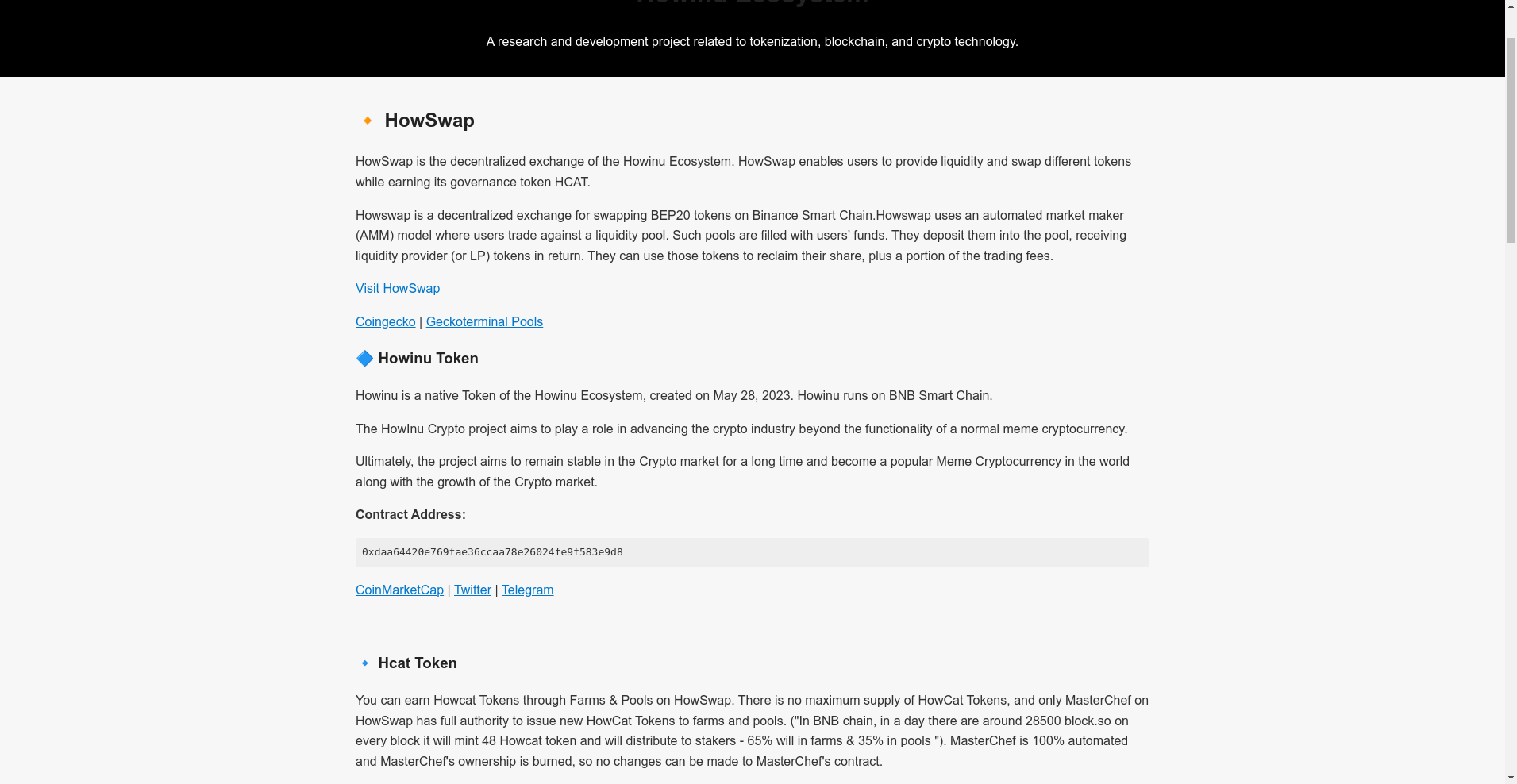Howcat ($HCAT) Review: A Data-Driven Look at Its Legitimacy and Risks

Project Overview
Howcat, operating on the Binance Smart Chain (BSC), positions itself as an integral part of the emerging meme cryptocurrency ecosystem. The project claims to focus on decentralization, community engagement, and token utility, with a suite of tokens and a decentralized exchange (DEX) designed to facilitate trading, staking, and liquidity provision.
This review aims to provide an **impartial analysis** of Howcat's technological foundation, security measures, tokenomics, and development trajectory. Its goal is to clarify the underlying strengths and vulnerabilities, helping potential investors assess the project's legitimacy and risk profile grounded solely in available data.
The Team and Vision Behind Howcat
There is limited publicly available information regarding the team behind Howcat. The project's core appears to be primarily operated through smart contracts with minimal transparency about individual contributors. No clear founding team members or advisors are publicly identified, which raises questions about long-term accountability and oversight. This lack of transparency can be a red flag, especially considering the importance of team credibility in assessing project legitimacy in the crypto sector.
Despite the limited direct team information, the project has outlined a roadmap centered on building a decentralized exchange, staking pools, and a series of tokens designed to interconnect ecosystems. The milestones achieved include deploying the core contracts, burn mechanisms for ownership control, and initial liquidity pools. These are standard steps for DeFi projects, but their success heavily depends on ongoing development, which appears to be routine based on audit updates.
Assessing the Security and Integrity of Howcat
Our security assessment is based solely on the audit report from Cyberscope, which reviewed Howcat's primary smart contracts on BSC. While this is a strongly recommended step, it still leaves gaps, as a single audit does not guarantee comprehensive security, especially if the scope is limited to specific contracts. Understanding how to read smart contract audit reports is crucial for any investor.
Key findings from the Cyberscope audit include:
- Contract Audited: Six core contracts, including the Decentralized Exchange modules and staking pools.
- Audit Status: Passed with no critical vulnerabilities reported at the time of review.
- Vulnerabilities Detected: The report highlights **no critical vulnerabilities** but notes some minor concerns typical for early-stage DeFi projects, such as the presence of standard owner privileges and insufficient off-chain monitoring. The potential for critical vulnerabilities in smart contracts requires careful examination of audit details.
- Ownership & Control: The MasterChef contract ownership has been burned, effectively decentralizing token issuance and staking management. This move enhances trustworthiness by removing a single point of failure.
- Security Score: An impressive score of 95.44 out of 100, suggesting strong code quality within the scope of the audit.
However, the audit’s focus on code review alone does not account for potential off-chain exploits, social engineering, or future governance vulnerabilities. Additionally, the project’s decentralization score is only 37/100, indicating significant central control or exposure to governance risks. This discrepancy urges caution, as a high security score on audit does not inherently equate to an entirely trustworthy or robust ecosystem.
In summary, while the security audit from Cyberscope points to a well-constructed smart contract architecture, the absence of multi-source security assessments and details about audit depth warrants caution for investors relying solely on these findings. Projects like Howcat often need to demonstrate more than just a good audit score; understanding their community engagement strategies can offer further insight.
A Breakdown of Howcat Tokenomics
The tokenomics of Howcat are designed to foster community engagement and liquidity incentives, but they also carry inherent risks typical of meme and DeFi projects without strict supply caps. This highlights the importance of understanding token inflation on BSC.
- Total Supply: No maximum supply for the HCAT token. This open-ended issuance could lead to inflationary pressures, reducing token value over time.
- Minting Mechanism: The MasterChef contract automatically mints approximately 48 HCAT tokens per block on BNB Chain, distributed as 65% to liquidity farms and 35% to pools.
- Issuance Control: The entire issuance process is automated, with the MasterChef owner burned, preventing manual adjustments or token minting control.
- Token Utility: HCAT is primarily earned through staking pools, with limited details on broader utility, governance, or burn mechanisms. Exploring projects with well-defined meme token utility beyond speculation is often a safer bet.
- Distribution & Allocation: The token's entire distribution is linked to staking, heavily incentivizing liquidity provision while diluting holder value due to continuous issuance.
This economic design inclines towards inflationary dynamics, which could diminish token value if demand does not keep pace with supply expansion. The lack of a capped supply increases risks of hyperinflation, especially if the community or new investors do not participate actively.
Assessing Howcat's Development and Ecosystem Activity
Based on the available data and audit reports, Howcat's development appears to be focused on deploying core contracts, obtaining audit approvals, and establishing initial liquidity pools. The project's step-by-step contract deployment and burn of ownership suggest a move toward decentralization, but the ongoing activity is primarily technical and infrastructure-oriented.
There are no significant marketing milestones or partnerships reported that demonstrate real-world traction beyond contract deployment. The project’s social media presence is moderate, with approximately 3,077 followers on X (Twitter) and 3,892 members in Telegram, which indicates some community engagement but not exceeding what is typical of small or nascent DeFi projects.
Long-term success will depend on sustained development, ecosystem expansion, and community adoption. Currently, measures of genuine activity, such as partnerships or ecosystem integrations, are absent or minimal, making it more of a DeFi framework presentation than a thriving ecosystem.
What Investors Should Know About Howcat's Legal and Terms Conditions
The available documentation appears standard and primarily consists of code and contract disclosures. No explicit legal disclaimer is available, and there are no stated investor protections or clear terms regarding dispute resolution, rights, or governance mechanisms beyond the contract code itself.
Given the absence of KYC, official legal frameworks, or regulatory compliance disclosures, potential investors should consider the inherent risks associated with unregulated DeFi projects. No legal protection is apparent, and the risk of smart contract vulnerabilities, rug pulls, or governance shifts remains. It’s also important to note that if a crypto project goes offline, knowing what to do can be challenging.
Furthermore, the open-ended token supply and continuous minting could pose risks in terms of inflation and dilution, especially without clear mechanisms for token buyback or burn strategies. As such, the legal framework is minimal, and due diligence should be taken seriously.
Final Analysis: The Investment Case for Howcat
From an analytical perspective, Howcat presents a classic DeFi meme token project with some security measures in place, such as the burned ownership of critical contracts and a high audit score. However, the absence of a capped supply, limited transparency regarding the team, and minimal real-world ecosystem activity suggest elevated risks. Its decentralization score also hints at lingering central points of control, which could be exploited or re-centralized under certain circumstances.
Prospective investors interested in speculative or meme-based projects should note that while the smart contract code appears solid, the project’s inflationary tokenomics and limited community or network effects increase the potential for value dilution or collapse. Understanding the tokenomics of projects is vital, with some projects offering limited use cases beyond trading, such as those where token utility is specific to its ecosystem.
On the risk side, the key concerns include inflationary supply dynamics, lack of a transparent team, and minimal ecosystem maturity. The security audit provides reassurance on code quality but does not eliminate social, governance, or operational risks.
In conclusion, Howcat's current standing indicates a cautiously optimistic outlook, but serious due diligence and risk assessment are necessary. It might appeal to high-risk traders aligned with meme tokens but is unlikely to be suitable for risk-averse or long-term value investors.

Amanda Harris
Technical Security Educator
Security professional passionate about the "human firewall." I translate complex crypto threats into simple, actionable security habits for everyday users.
Similar Projects
-
UMA
UMA ($UMA) Review: A Deep Dive into Its Tech & Risks
-
CreedDao
In-Depth Review of CreedDao: Crypto Scam Checker & Project Scam Review
-
ShapeShift FOX Token
ShapeShift FOX Token Review: Legitimacy, Risks & Long-Term Potential
-
CIPHER EPAY
CIPHER EPAY ($CPAY) Review: Tech, Risks & Transparency Insights